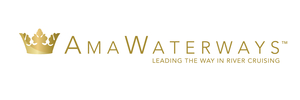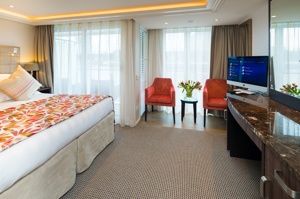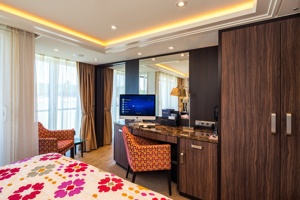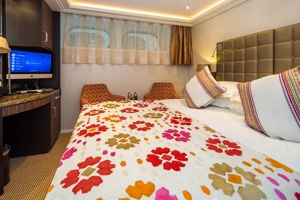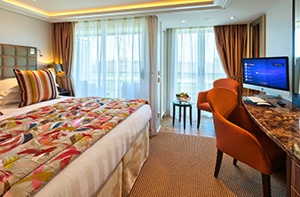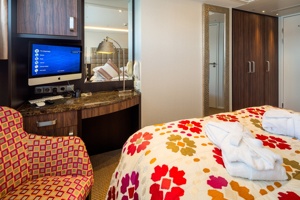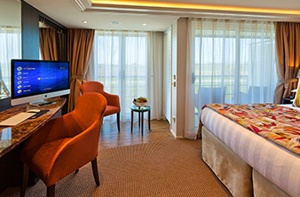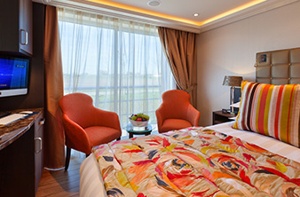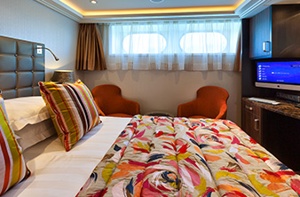Designed with a soft palette of elegant pale pinks and blues and appointed with our signature twin balconies in most staterooms, AmaLea is a sleek river ship created with luxury yachts in mind. A host of comforts and conveniences fill her decks, including a massage and hair salon, gift shop and specialty coffee station. The relaxing Sun Deck features a heated pool as well as a swim-up bar, while the vibrant Main Lounge provides an exhilarating stage for nightly performances. Enjoy an evening dining experience like no other at The Chef's Table, where rustic wooden floors, contemporary lighting and a glass-enclosed kitchen combine to form the stunning backdrop for your gastronomic entertainment. And with a walking track on the Sun Deck, a fitness room and a fleet of onboard bicycles, you'll have everything needed to stay active and healthy while sailing Europe's great rivers.
Cruise ID: 53241
As the first river cruise line to carry a fleet of complimentary bicycles on board, we are proud to offer included excursions for you to pedal into historic city centres and along the riverbanks. Cycle through three countries: Switzerland, France and Germany while your ship remains in Lucerne; bike to Germany's Roman-inspired Walhalla Memorial; glide among the historic UNESCO-protected windmills of Kinderdijk and so much more.
EUROPE
7-Night Cruise - Ship's Crew: The entire amount will be divided equally amongst all crew members. Recommendation: 100 Euros per 7-night cruise, per guest. (AmaMagna 120 Euros per 7-night cruise, per guest)
7-Night Cruise - Cruise Manager: Your Cruise Manager is not part of the ship's crew and is the AmaWaterways representative who also accompanies you on any pre- and/or post-cruise hotel/land extensions you may have booked. Recommendation: 25 Euros per 7-night, per guest; 4 Euros for each additional day, per guest for pre- and post-cruise hotel/land extensions.
10-Night Cruise - Ship's Crew: The entire amount will be divided equally amongst all crew members. Recommendation: 143 Euros per 10-night cruise, per guest.
10-Night Cruise - Cruise Manager: Your Cruise Manager is not part of the ship's crew and is the AmaWaterways representative who also accompanies you on any pre- and/or post-cruise hotel/land extensions you may have booked. Recommendation: 36 Euros per 10-night, per guest; 4 Euros for each additional day, per guest for pre- and post-cruise hotel/land extensions.
11-Night Cruise - Ship's Crew: The entire amount will be divided equally amongst all crew members. Recommendation: 158 Euros per 11-night cruise, per guest.
11-Night Cruise - Cruise Manager: Your Cruise Manager is not part of the ship's crew and is the AmaWaterways representative who also accompanies you on any pre- and/or post-cruise hotel/land extensions you may have booked. Recommendation: 40 Euros per 11-night, per guest; 4 Euros for each additional day, per guest for pre- and post-cruise hotel/land extensions.
14-Night Cruise - Ship's Crew: The entire amount will be divided equally amongst all crew members. Recommendation: 200 Euros per 14-night cruise, per guest.
14-Night Cruise - Cruise Manager: Your Cruise Manager is not part of the ship's crew and is the AmaWaterways representative who also accompanies you on any pre- and/or post-cruise hotel/land extensions you may have booked. Recommendation: 50 Euros per 14-night, per guest; 4 Euros for each additional day, per guest for pre- and post-cruise hotel/land extensions.


